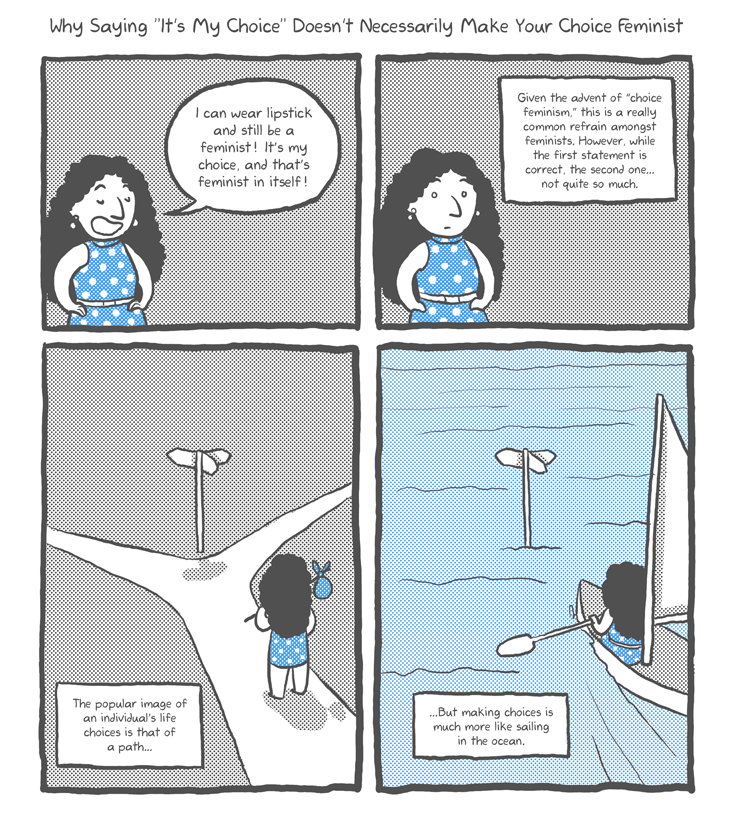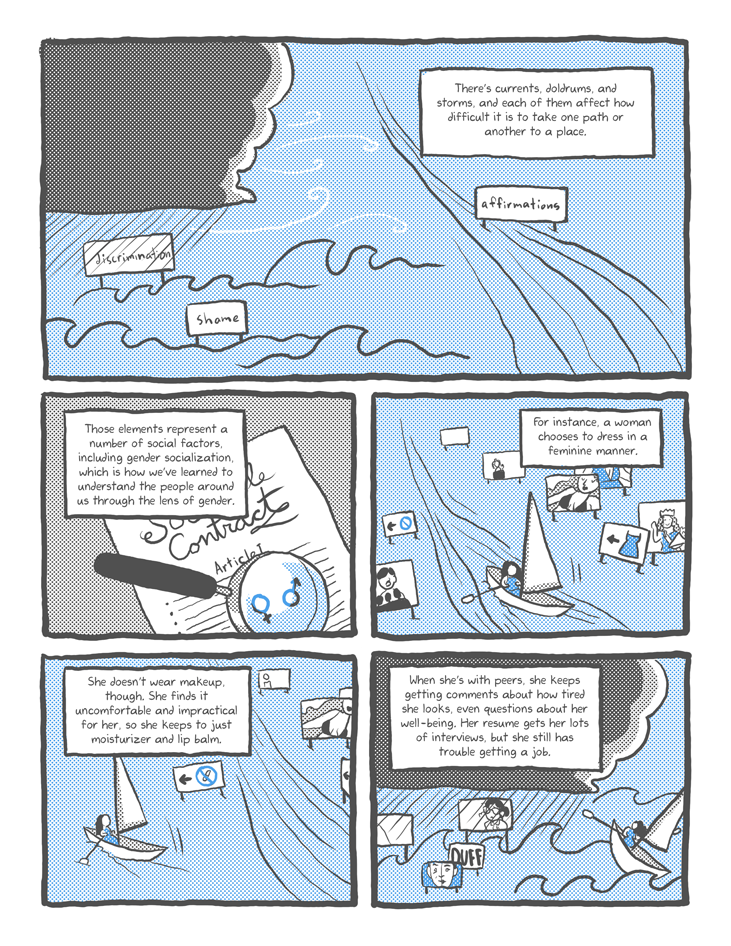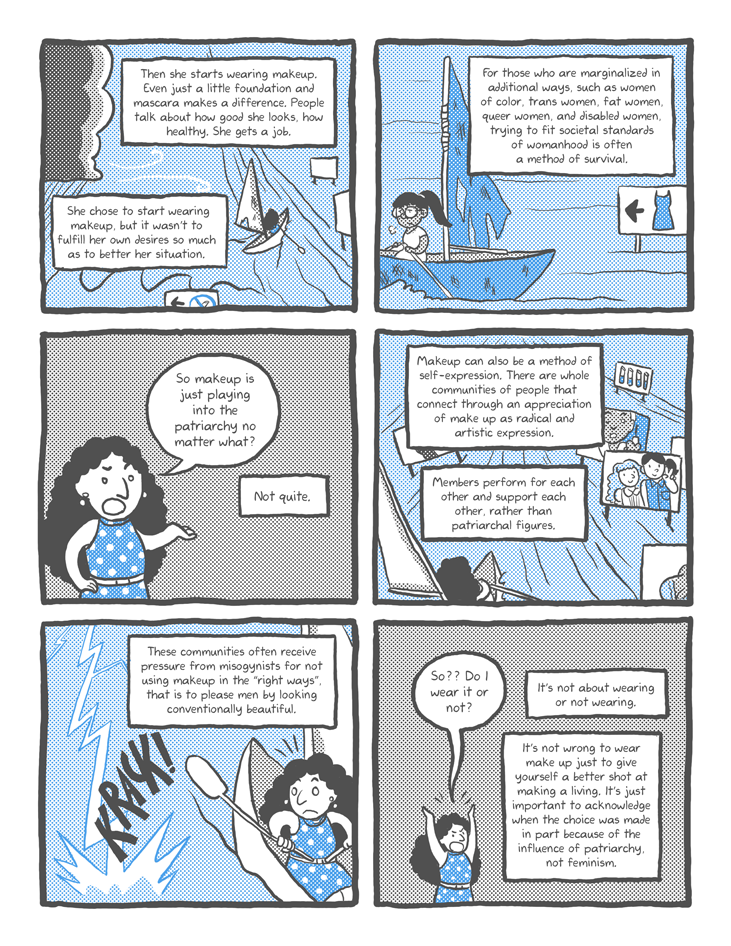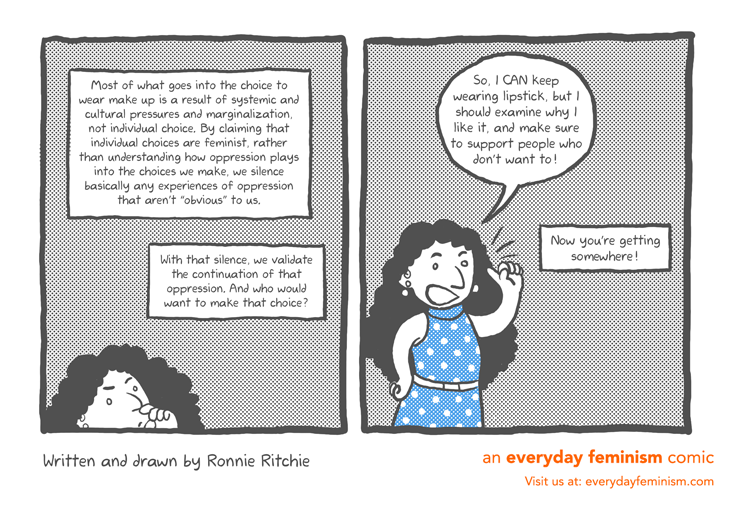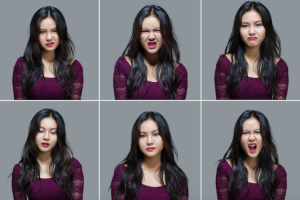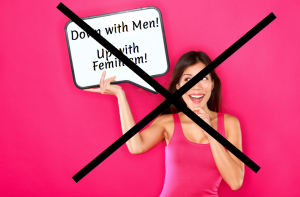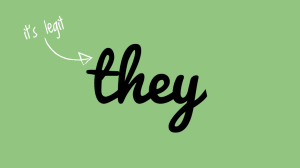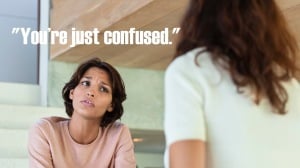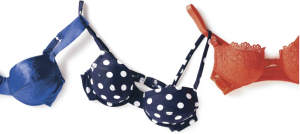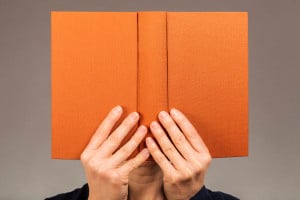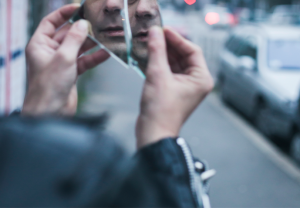Panel 1
Character: (Wearing traditionally feminine attire, with hands on hips) I can wear lipstick and still be a feminist! It’s my choice, and that’s feminist in itself!
Text: Given the advent of “choice feminism,” this is a really common refrain amongst feminists. However, while the first statement is correct, the second one… not quite so much.
Panel 2
Character: (Standing at a crossroads with two signs, each pointing down one of the paths)
Text: The popular image of an individual’s life choices is that of a path.
Panel 3
Character: (Now on open water in a boat. The road sign pokes out over the waves.)
Text: But making choices is much more like sailing in the ocean
Panel 4
Text: There’s currents, doldrums, and storms, and each of them affect how difficult it is to take one path or another to a place.
(Panel shows the open ocean with a current going through the middle, marked by signs labeled “affirmations”. On one side, the water is completely still. On the other, a hurricane rages, with signs labeled “discrimination” and “shaming”.)
Panel 5
Text: Those elements represent a number of social factors, including gender socialization, which is how we’ve learned to understand the people around us through the lens of gender.
(There is a piece of paper, with “Social Contract” in fancy writing. A magnifying glass hovers over the contract, and inside is the symbols for male and female.)
Panel 6
Text: For instance, a woman chooses to dress in a feminine manner.
Character: (The character represents the hypothetical woman, steering her boat in direction of a sign with a dress on it.)
Panel 7
Text: However, she doesn’t wear makeup. She finds it uncomfortable and impractical for her, so she keeps to just moisturizer and lip balm.
Character: (As she passes the sign with the dress, she turns her boat into stiller waters, marked with a sign with an X through a tube of lipstick. In the distance are signs of conventionally attractive women with makeup with affirmations about their beauty, dressed as queens, etc. The stiller waters have signs featuring women that look tired and overworked, decidedly unhappy.)
Panel 8
Text: When she’s with peers, she keeps getting comments about how tired she looks, even questions about her well-being. Her resume gets her lots of interviews, but she still has trouble getting a job.
Character: (Encountering a storm, struggles to keep paddling in her current direction)
Panel 9
Text: Then she starts wearing makeup. Even just a little foundation and mascara makes a difference. People talk about how good she looks, how healthy. She gets a job. She chose to start wearing makeup, but it wasn’t to fulfill her own desires so much as to better her situation.
Character: (The woman turns back into the current, ship battered)
Panel 10
Text: For those who are marginalized in additional ways, such as women of color, trans women, fat women, queer women, and disabled women, trying to fit societal standards of womanhood is not only a choice of what is most appealing, but of what will help them survive.
(Another person sails down the same current as the previous one, but is still pelted by rain from storms)
Panel 11
Character: So makeup is just playing into the patriarchy no matter what?
Text: Not quite.
Panel 12
Text: Makeup can also be a method of self-expression. There are whole communities of people that connect through an appreciation of make up as radical and artistic expression. Members perform for each other and support each other, rather than patriarchal figures.
Character: (In the current, but new signs appear amongst the images of conventionally beautiful women. The signs contain pictures of people in makeup taking pictures together, and of makeup tutorials. These styles of makeup vary much more than the original signs.)
Panel 13
Text: They often even receive pressure from misogynists for not using makeup in the “right ways,” that is to please men by looking conventionally beautiful.
Character: (Even while in the current, she encounters storms)
Panel 14
Character: So?? Do I wear it or not?
Text: It’s not about wearing or not wearing. It’s not wrong to wear make up just to give yourself a better shot at making a living. It’s just important to acknowledge when the choice was made in part because of the influence of patriarchy, not feminism.
Panel 15
Text: Most of what goes into the choice to wear make up is a result of systemic and cultural pressures and marginalization, not individual choice. By claiming that individual choices are feminist, rather than understanding how oppression plays into the choices we make, we silence basically any experiences of oppression that aren’t “obvious” to us. With that silence, we validate the continuation of that oppression. And who would want to make that choice?
Character: (Standing, pondering these words)
Panel 16
Character: So, I can keep wearing lipstick, but I should examine why I like it, and make sure to support people who don’t want to!
Text: Now you’re getting somewhere!
